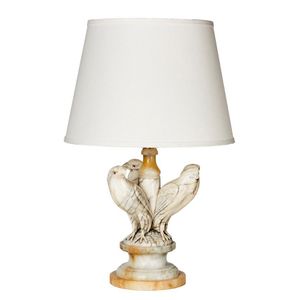Bronze Grand Tour Warwick Vases with Classical Masks
You must be a subscriber, and be logged in to view price and dealer details.
Subscribe Now to view actual auction price for this item
When you subscribe, you have the option of setting the currency in which to display prices to $Au, $US, $NZ or Stg.
- Lion's Paw - The decorative lion's paw has been used in furniture, silver, and ceramics for centuries. It is a stylized representation of the paw of a lion, often depicted in a highly realistic or stylized form.
In furniture design, lion's paws were popular in the neoclassical and Empire styles of the late 18th and early 19th centuries. They were often used as feet on tables, chairs, and other pieces of furniture. The lion's paw was a popular motif for furniture makers because it added a sense of grandeur and regalness to their pieces.
In silverware design, the lion's paw was often used on the feet of tea and coffee pots, as well as on other pieces of silverware such as wine coolers and tureens. The lion's paw was often used in combination with other neoclassical motifs, such as acanthus leaves or grape clusters, to create a sense of grandeur and classical elegance.
In ceramics, lion's paws were commonly used as feet on vases, urns, and other pottery items. The lion's paw was often depicted in relief or as a highly stylized form, and was sometimes used in combination with other decorative elements, such as garlands or swags. - Bronze - An alloy of copper and tin, traditionally in the proportions of about 9 parts of copper to 1 part of tin.
The discovery of bronze in Western Asia in the 4th century enabled people to create metal objects which were superior to those previoulsy possible because of its strength and hardness, and it has been used throughout the world for weapons, coins, tools, statuary and other decorative items.
It is very fluid in a molten state, and its hardness, strength when set, and non-corrosive properties makes it most suitable for casting sculpture. - Circa - A Latin term meaning 'about', often used in the antique trade to give an approximate date for the piece, usually considered to be five years on either side of the circa year. Thus, circa 1900 means the piece was made about 1900, probably between 1895 and 1905. The expression is sometimes abbreviated to c.1900.
This item has been included into following indexes:
Visually similar items

A first period Worcester chestnut basket, cover and stand, circa 1770, of quatre-lobed oval form, printed in blue with the pinecone pattern, the twig handles with applied flowers and leaves at the terminals, the stand and cover modelled with arching panels

A finely carved marble lamp base, modelled as three Eagles. The base 47 cm high, 26 cm wide and deep

A pair of ornate large cast iron brass andirons, double graduated urn form finial tops with pineapple, floral, mask and dolphin detail above the main brackets with cherub mask and figures, floral swags and dolphin head feet, plain steel brackets behind. He

Beswick Shire horse, 21 cm high approx.
